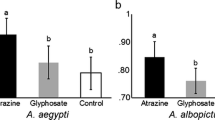Abstract
The insect growth regulator, Lufenuron, at concentrations of even multiples of LC90 (determined under laboratory conditions) was tested against the III instar larvae of Aedes aegypti under simulated field conditions. For all concentrations tested, 100 % mortality of the larvae was observed within 24 h of exposure to Lufenuron-treated water. In experiments with LC90 × 4 Lufenuron concentration and where 15 % of water volume was replaced daily, percent mortality of the larvae was reduced to 40 % after the 54th day of treatment. Percentage mortality of the III instar larvae on the 54th day was higher in water with LC90 × 6 concentration than that observed for water with LC90 × 4 of Lufenuron. In the experiments with LC90 × 4 and LC90 × 6 concentrations of Lufenuron where 15 % of water volume was replaced weekly, larval mortality obtained after the eighth week was 68.75 and 88.33 %, respectively. In LC90 × 4 and LC90 × 6 of Lufenuron-treated stagnant water (without replacement of water), the percent mortality of the larvae on the 55th day was 65 and 90 %, respectively. Introducing a fresh batch of III instar A. aegypti larvae in the Lufenuron-treated waters revealed that residual activity of Lufenuron was sustained for 45 days after the treatment. All these experiments revealed that Lufenuron not only affects the prevalence of the A. aegypti larvae but also induces the development of abnormal adults.






Similar content being viewed by others
References
Busvine JR (1957) A critical review of the techniques for testing insecticides. Commonwealth Institute of Entomology, London, 56, Queens gate, S. W. 7
Dorta DM, Chiong RT, Ortega AN, Quinones FAG (1989) Estudio de la sensibilidad al Dimilin (Diflubenzuron) en una cepa de Aedes (S) aegypti Linnaeus,1762 y de Culex (C) quinquefasciatus Say, 1823 criadas en el laboratorio. Rev Cubana Med Trop 41:56–63
Finney DJ (1971) Probit analysis, 2nd edn. Cambridge University Press, Cambridge
Indra V, Belleza M, Rochani H, Tan SB, Tan CH (2005) Laboratory and field evaluation of the insect growth regulator pyriproxifen (Sumilarv 0.5G) against dengue vectors. J Am Mosq Control Assoc 21(3):298–300
Joseph CC, Nodile MM, Malima RC, Nkuniya MHM (2004) Larvicidal and mosquitocidal extracts, a coumrin, isoflavonoides and petrocarpans from Neorautaenia mitis. Trans R Soc Trop Med Hyg 98:451–455
Killen GF, Fillinger U, Knolls BGJ (2002) Advantage of larval control for African malaria vector’s low mobility and behavioral responsiveness of immature mosquito stages allow high effective coverage. Malar J 1:8
Lima JBP, Cuna MF, Silva-Junior RC, Galardo AKR, Soares SS, Braga IA, Ramos RP, Valee D (2003) Resistance of Aedes aegypti to organophosphates in several municipalities in state of Rio de Janerio and Espirito santo, Brazil. Am J Trop Med Hyg 88:329–333
Martins FS (2004) Avaaliacao da atividade inibidora do Diflubenzuron na ecdiase das larvas de Aedes aegypti (Linnaerus, 1762) (Diptera: Culicidae). Rev Soc Bras Med Trop 37:135–138
Mulla MS (1991) Insect Growth Regulators for the Control of Mosquito Pests and Disease Vectors. Chinese J. Entomology, Special issue No. 6 Proceedings of the IV National Vector Control Symposium: 81–91
Mulla MS, Thavara U, Tawatsin A, Chompoosri MZ, Su T (2003) Laboratory and field evaluation of novaluron, a new acylurea insect growth regulator, against Aedes aegypti (Diptera: Culicidae). J Vector Ecol 28:241–254
Nayar JK, Ali A, Zaim M (2002) Effectiveness and residual activity comparison of granular formulations of insect growth regulators pyriproxyfen and s-methoprene against Florida mosquitoes in laboratory and outdoor conditions. J Am Mosq Control Assoc 18:196–201
Siddall JB (1976) Insect growth regulators and insect control: a critical appraisal. Environ Health press 14:119–126
Ware GW (2000) The pesticide book, 5th edn. Thomas, Fresno, p 415
WHO (1995) Vector control of malaria and mosquito born diseases. A report of WHO study group. World Health Organ Tech Rep Ser 857:1–31
Yapabandra AMGM, Curtis CF (2002) Laboratory and field comparisons of pyriproxyfen, polystyrere beds and other larval methods against malaria vectors in Sri Lanka. Acta Trop 8:211–223
Acknowledgments
This study was supported by University Grant Commission, New Delhi, India ref. no. 32–515/2006(SR.), a major research project.
Conflicts of interest
The authors declare they have no conflicts of interest.
Author information
Authors and Affiliations
Corresponding author
Rights and permissions
About this article
Cite this article
Salokhe, S.G., Deshpande, S.G. & Mukherjee, S.N. Evaluation of the insect growth regulator Lufenuron (Match®) for control of Aedes aegypti by simulated field trials. Parasitol Res 111, 1325–1329 (2012). https://doi.org/10.1007/s00436-012-2968-9
Received:
Accepted:
Published:
Issue Date:
DOI: https://doi.org/10.1007/s00436-012-2968-9




